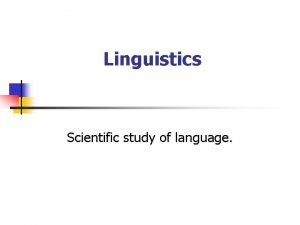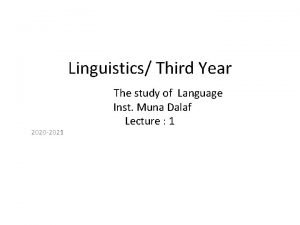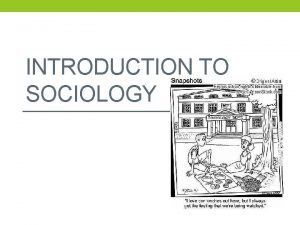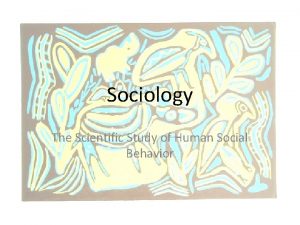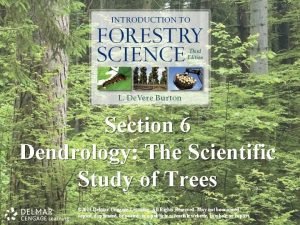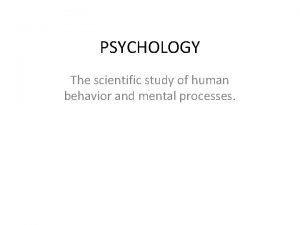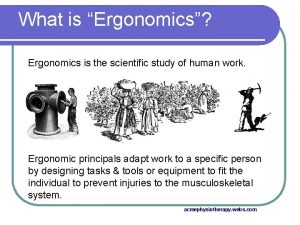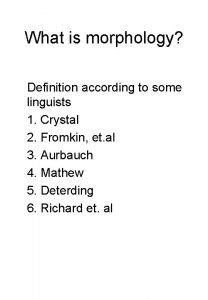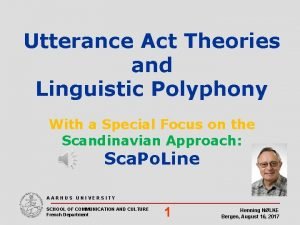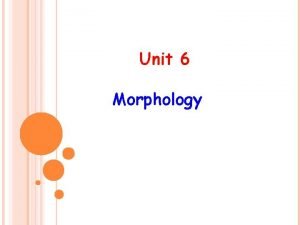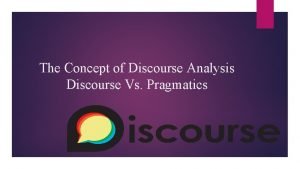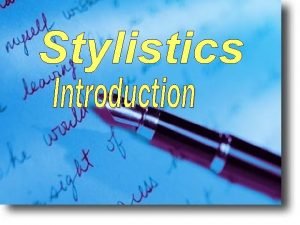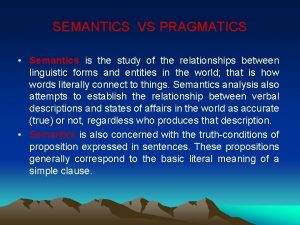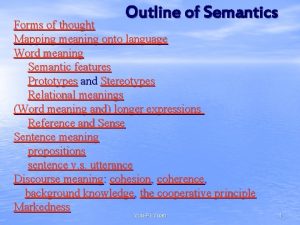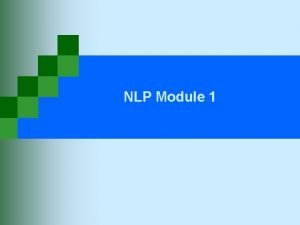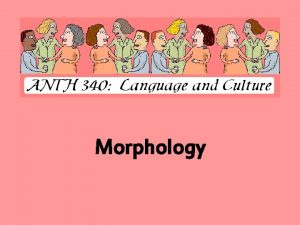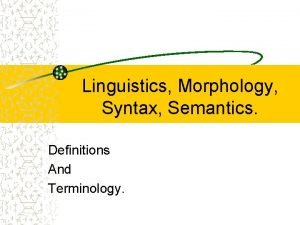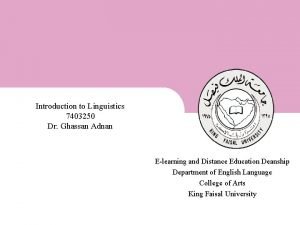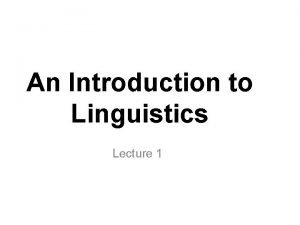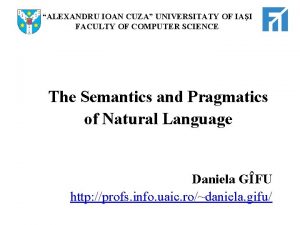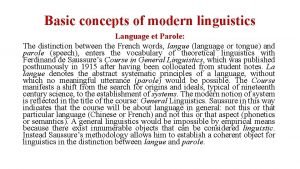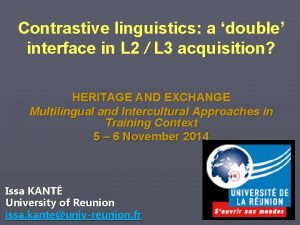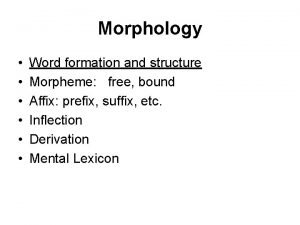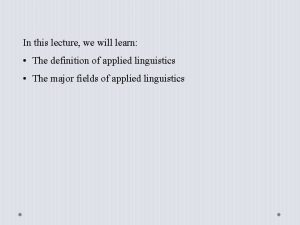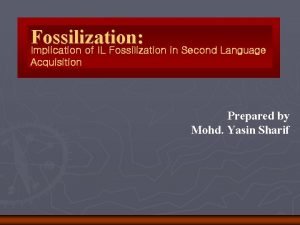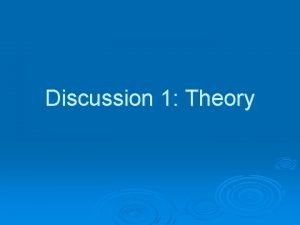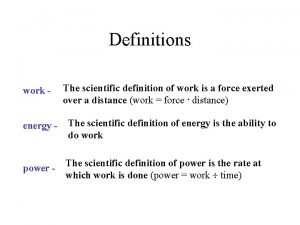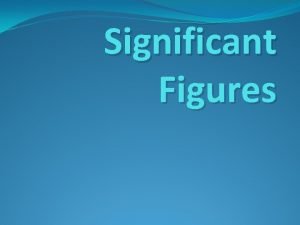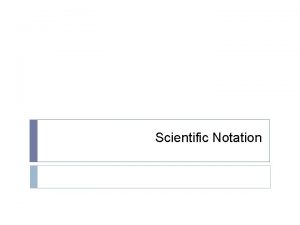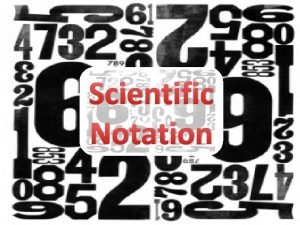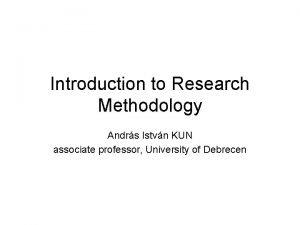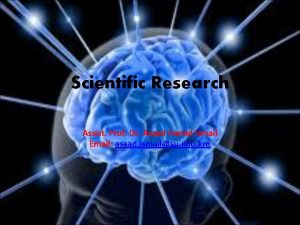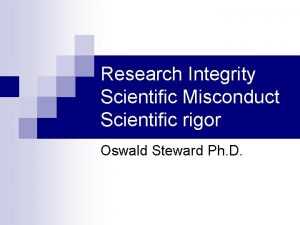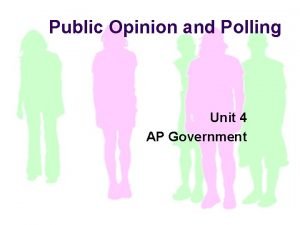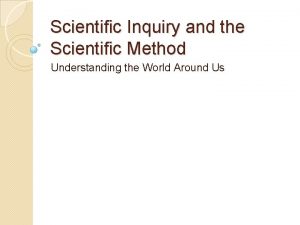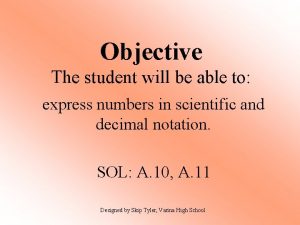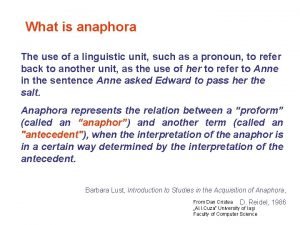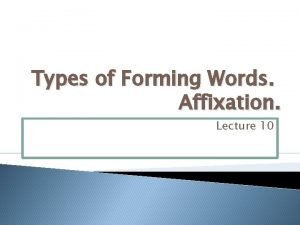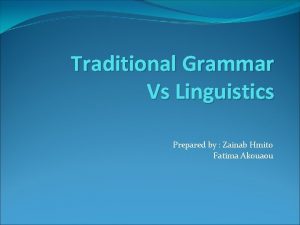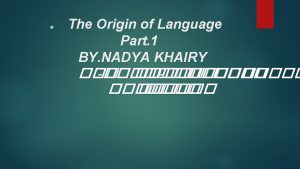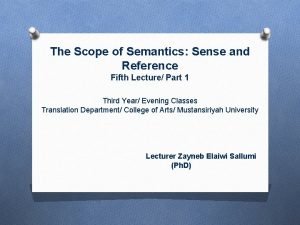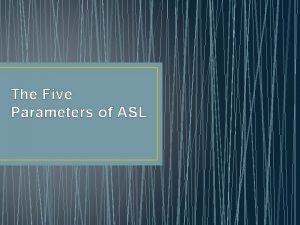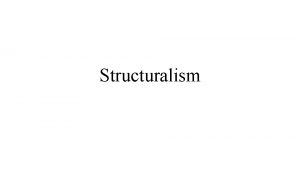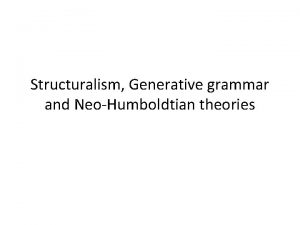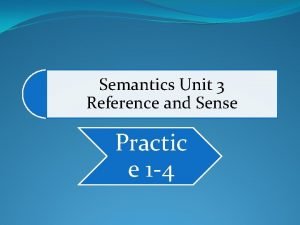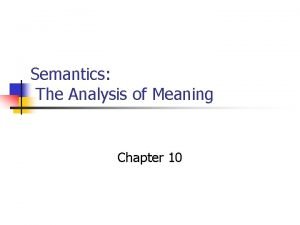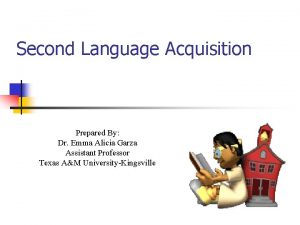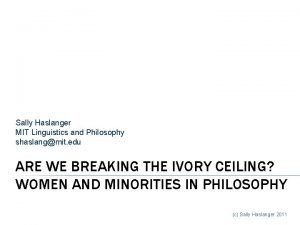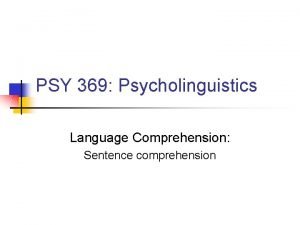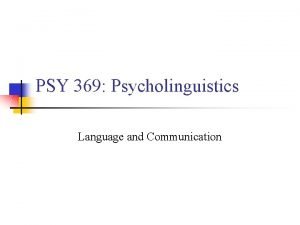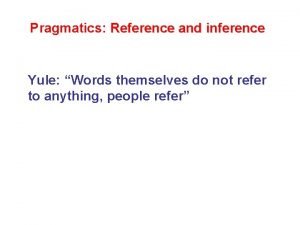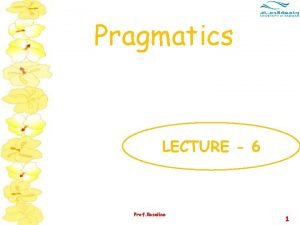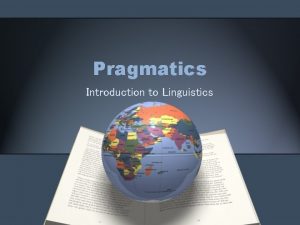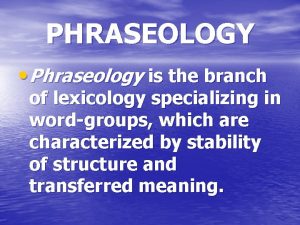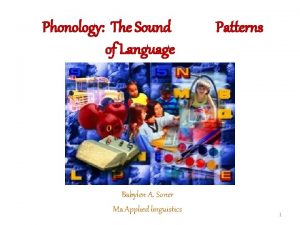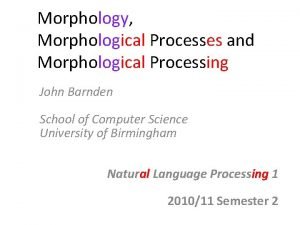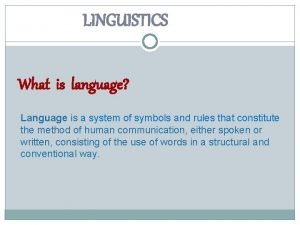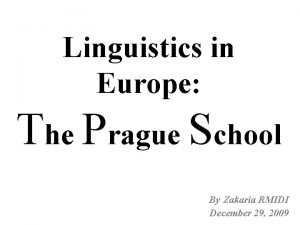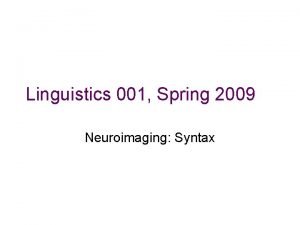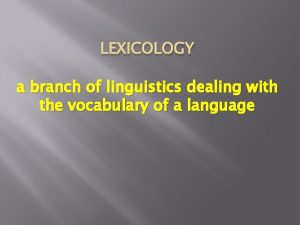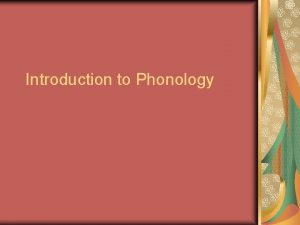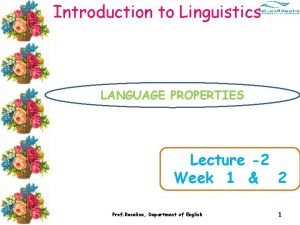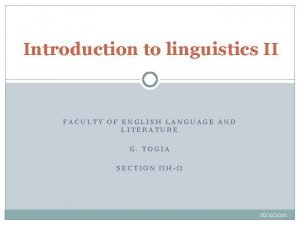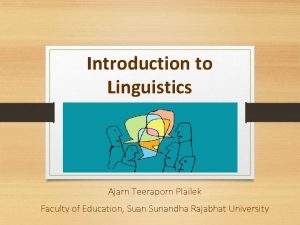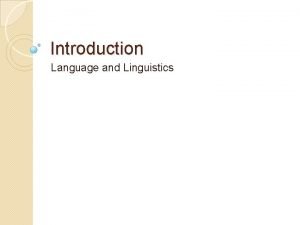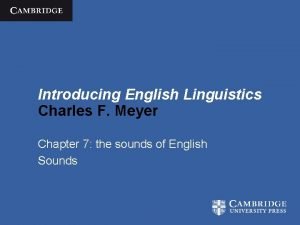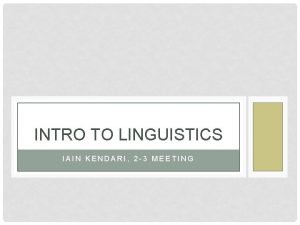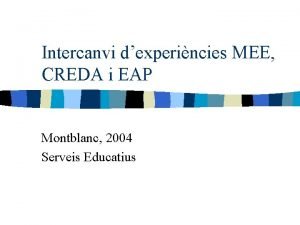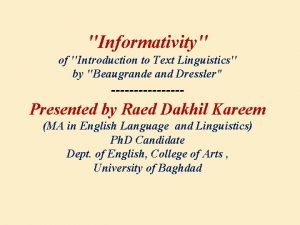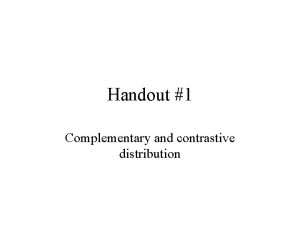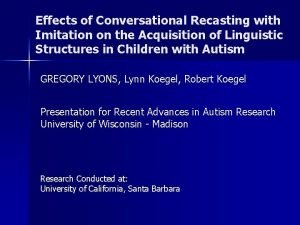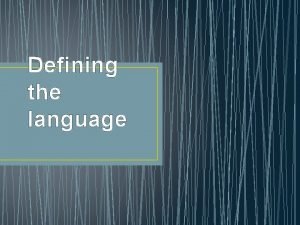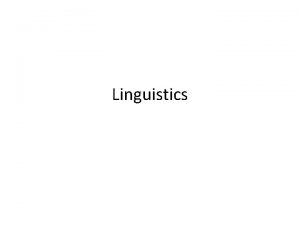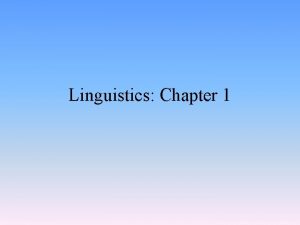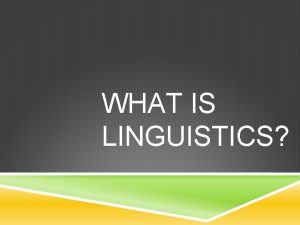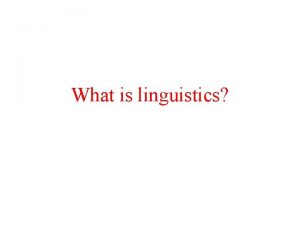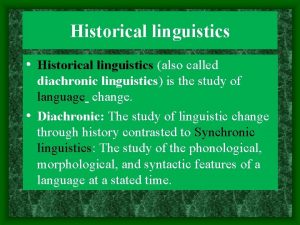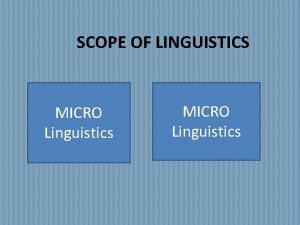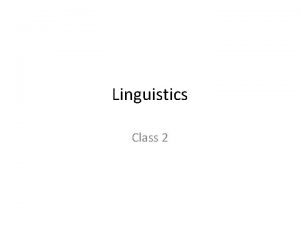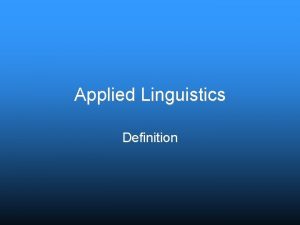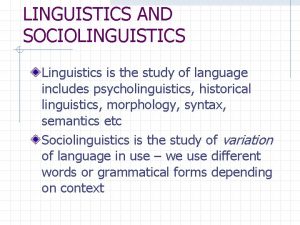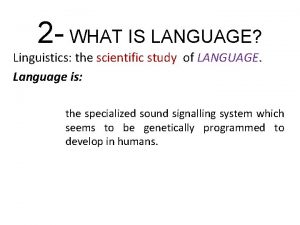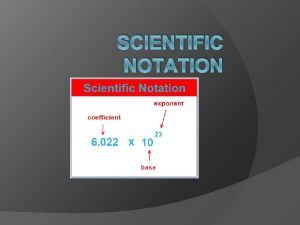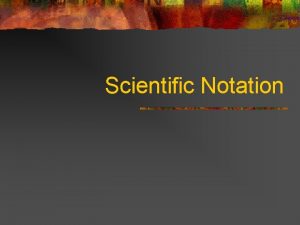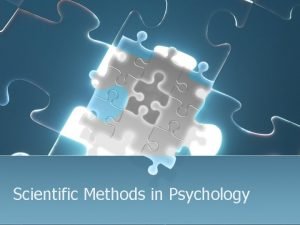Definition of Linguistics Linguistics is the scientific study
































































































































































- Slides: 160

Definition of Linguistics

• Linguistics is the scientific study of human language. As such, it regards the ways in which members of a particular discourse community conceptualize their experience, encode it in a linguistic form, and then use that code in social interaction. Language powerfully conditions all our thinking about social problems and processes. This explains why the systematic study of a language necessarily regards both cognition (the way in which language structures thoughts in the human mind) and communication ( the way in which language serves social interaction).

• Indeed, as we acquire language during childhood, we also discover: a) our identity as individual ( when we use it to refer to ourselves and our ideas or options) and, b) our identity as social beings ( when we communicate with other people).

Focus on Language as Cognition • In Chomsky’s Transformational-Generative Grammar the aim of Linguistics is not simply to focus on how language is structured. In fact, he is principally interested in understanding more about language in order to understand more about the processes of the human mind. Chomsky starts from the observation that although different groups of people speak different languages, all human languages are similarly governed by common rules, or principles that are universal. Every language has rules that govern pronunciation, word formation and sentence construction, providing a means for making assertions or request, asking questions, and so on.

• This means that languages differ from each other only at the level of their surface structure, but their deep structure is the same, reflecting the general rules of a universal linguistic system typical of the human species. This universal linguistic system is a genetic endowment of all human beings. Chomsky defines it as an innate Language Acquisition Device (LAD) genetically programmed in the human brain. The LAD provides a series of common grammatical principles, or Universal Grammar (UG) and their realizations as variable parameters to be adapted to the varying “settings” of the different languages.

• The presence of the LAD in the human brain would explain why language development in children occurs so easily and spontaneously, and does not requires any explicit teaching of the grammar rules on the part of the adults. Moreover, children are extremely creative in their use of language, because they can say and understand words that they have never heard before. In Chomsly’s perspective, therefore, language is exclusively a cognitive, abstract knowledge developing in the human mind completely detached from the social context in which it is used. This, in fact, represents another way of looking at language- that is, as a socially motivated system developed to allow social communication. Let us analyze this different point of view on language as it is expressed by Michael Halliday.

Language and the human society. • Focus on Language as Commnication • In Halliday’s Systemic-Functional Grammar the purpose of Linguistics is concerned with the study of language as social semiotic, that is to say, as a system of signs that have been developed to serve the communicative needs of people living in a social context. In other words, Halliday intends language not as a biological evolution of the human beings’ brain (as in Chomsky’s theory, but as a sociocultural evolution prompted by the human beings’ need to communicate with each other within their own communities. This means that language has evolved within a specific community in such a way that it fulfils three main functions:

• the Ideational Function, concerned with people thinking with language in order to interpret experience; • the Interpersonal Function, concerned with people acting with language in order to achieve interpersonal communication; • the Textual Function, concerned with the linguistic organization of a message.

• These functions, in Halliday’s view are realized differently in different languages because they are coded into semantic and syntactic structures that reflect the different “social semiotic” of different communities. Within each community, this semantic and syntactic code (representing the “grammatical system” of its language) allows the expression of the social behavior of people using it in various situational contexts, Within the grammatical resources of their code, people are free to choose those structures that best convey their expressive and communicative intents.

Perspective on Competence • Chomsky states that Linguistics should regard exclusively an abstract knowledge of language which he defines as competence. Then, he dissociates competence from the actual use of language, or performance. Contrary to this view, Dell Hymes argues that language is not simply an abstract, idealized knowledge of rules, but it is also the use of these rules to achieve communication (communicative competence).

• Gumperz and Levinson claim that the rules of use in the various language are different because they reflect the different socio-cultural experiences of their users (linguistic relativity).

The Experientialist Perspective • A more recent Cognitive-Functional approach to grammar, informed by the Experientialist view in Cognitive Linguistics have to some extent succeeded in bringing together these two theories under a common rationale. To Cognitive-Functional linguists, language is systematically grounded in human cognition since it is a conceptual system that emerges from people’s everyday experience of their own physical and sociocultural environment.

Synchronic and diachronic studies of language. • Saussure vs Sweetser • We have previously defined language as species-specific because it has evolved only in human beings to represent our views of the external world to our mind (cognition), and to communicate our views to the other people (communication). Now we shall begin by briefly examining two principal trends in linguistic studies.

• Synchronic linguistics studies the present state of a language. As such it generally ignores language evolution and supports the concept of arbitrariness. The Swiss linguist Ferdinard de Saussure, the leading scholar of this synchronic current, maintains that words are only arbitrarily associated with the real things they refer to. This is demonstrated by the fact that different words in different languages indicate the same thing. Saussure asserts that language is “organized thought coupled with sound”.

• In other words, an auditory image becomes associated with a concept. This view brought Saussure to formulate his theory of the sign that result from associating a signified with a signifier, but the bond between the signifier and the signified is arbitrary. For example, the same concept of a tree (signified) is arbitrarily associated with different words in different languages (signifiers).

• Diachronic Linguistics studies the evolution of a language over time and maintains that the sounds of languages are originated from a non arbitrary common root reproducing people’s initial physical experience in the world through the five senses: hearing, touch, taste, smell, and sight. This is demonstrated by the fact that words indicating, for instance, the noise of a dog in various languages derive from the same original root-sound.

• • • /b/ It. abbaiare, Ingl. bark, Ted. bellen, Fr. aboyer.

• Cognitive linguist Eve Sweetser argues that Generative grammar has rigidly separated synchronic semantic structure from historical change: most formal-semantic analyses to data have thus treated meaning change as inherently irrelevant to analysis of the synchronic system, therefore theory is constructed without reference to diachrony.

LANGUAGE IN SOCIOCULTURAL CONTEXTS Language as Social Identity Diatopic and Diastratic Variations • Varieties are general variations occurring within the code of the same language ( for ex. British and American variety of English). • Dialects are local, regional varieties that differ from the standard language code in relation to morphology, lexicon, syntax, and phonology.

Accents are regional varieties of a language that differ from the standard code only in relation to phonology ( various America, British, Australian accents). Variation in accent has also a social dimension, and this is often defined in terms of social status and prestige of the speakers.

In Britain, for example, the prestige accent is the Standard English, the variety developed and spoken in the South- East of England, that is to say, in the area that includes London and the prestigious university towns of Oxford and Cambridge. Standard English is also called Received Pronunciation and codified in the phonemes of the International Phonetic Alphabet.

• Language variation, therefore, can be summarized into two main types: • Diatopic variation, depending on the place where it occurs. For ex: • English spoken as the first, native language in England, Scotland, Wales, Ireland…. • English spoken as a second language in the ex British colonies of Africa, Middle East, South. East Asia….

• English spoken as a second language within communities of immigrants living in Englishspeaking countries. • English spoken by people living in non-English -speaking countries, who use or learn it as a foreign language or as a lingua franca in intercultural or international communication.

• Diastratic variation, depending on the social status of its speakers. For ex: English spoken by London working classes ( Cockney); by New-York Jews ecc. • Therefore we can say that the allophones mark the speaker’s identity, because they reveal the human group the speaker belongs to. In other words, our pronunciation-of both language-1

(L 1, our native language ) and language-2 (L 2, our second or foreign language)- reveals a complex system of social meanings that we acquire in the course of our life. Indeed, a spoken language can be perceived as refined or vulgar depending on different socio-cultural contexts that reflect specific values and roles.

So, for example, the so-called Cockney pronunciation in British English, used by the working classes of London, is normally perceived in Britain as the low-status and vulgar. This diastratic variety of English is principally characterized by an accent marked by the diphthong (ai) that is an allophone of the phoneme (ei). Ex day

Pidgin and Creole varieties Another source of diastratic assessment of social status on diatopic basis is represented by the pidgin and creole varieties of English. These are varieties spoken by people from the ex British colonies. A pidgin variety is a simplified version of a non-native language that developed in colonial contexts.

As such, it often contains many lexical and grammatical features transferred from indigenous languages. A creole variety is a language developed from a pidgin by acquiring a more complex grammar and it can have native speakers.

Often, pidgin speakers refuse to conform to the standard language variety because they consider it as the language of the colonizers, whereas they perceive pidgin and creole varieties as expressions of their own national and socio-cultural identities.

Indeed, in many cases, pidgin and creole speakers have even rejected the conventional orthography of the standard language, preferring instead transcriptions made according to their own indigenous spelling.

Differently from the majority of people from the ex British colonies, who value their ethnic origins reflected in their English accent, many educated people from the ex British colonies of India and South-East Asia are generally very eager to drop their local-English accent and acquire a Standard-English pronunciation. Shumann defines this phenomenon as acculturation.

Acculturation is the process by which people get adapted to a new culture by internalizing its system of thought and beliefs together with its system of communication through its language. People who acculturate to a new language have an integrative motivation, which involves their use of language to mark them as members of the particular social group they want to belong to.

If, on the contrary, they want to mark their sociocultural and psychological distance from the dominant social group who imposes its own language on them, then pidginization and creolization processes prevail. In sociological terms, Acculturation is part of a larger phenomenon called Passing, which occurs when people represent themselves differently from the way they actually appear to be.

Movement and Position Schemata: a Cognitive view of English Preposition

Preposition: Physical/Esperiential Interaction with the Spatial Environment The basic meaning of preposition is protoptypically spatial- that is to say, it has evolved during the prelinguistic stages of cognition, when the earliest human beings became conscious of their physical interaction in the space with the concrete, natural environment. From this interaction, human beings developed their own cognitive schemata of movement and position, which were subsequently conceptualized into specific semantic categories in their languages.

Standard English, (being a language of Indo. European origin- that is to say, derived from the proto-language that is supposed to be at the origins of today’s European and some Middle. Eastern languages) has the semantic categories of “movement” and “position” linguistically realized by prepositions. Prepositions, therefore, generally indicate a spatial schematic relationship of some sort between two entities.

Let us examine the nature of these cognitive schemata and how they are semantically conceptualized into English prepositions. We shall start from the “prepositions of movement”.

• Prepositions of movement: • The primary movement schema, underlying all the prepositions of movement in English, is the Image Schema constituted by a Container (prototypically represented by s circumscribed environment and a Force-Dynamic Subject (prototypically represented by an animate being) self determining its movement trajectory through space.

• From (It. da - provenienza) • I come from Liverpool. • To mentally represent the specific image of from, visualize the Force-Dynamic Subject (a person, for ex. ) who has left the Container previously containing him/her and now moves away.

• To ( It. a – destinazione ) • Every day I go to London. • The image schema of to is represented be the Force-Dynamic Subject moving in the direction of a Container.

• At (It. a – giungere a destinazione) • Usually, I arrive at the station early. • At is schematically visualized as the Force. Dynamic Subject that stops his/her trajectory when s/he reaches a Container.

• On (It. su – breve movimento in salita) • I get on the train. • The image schema of on is visualized as the Force-Dynamic Subject that is initially outside the Container, but then s/he climbs a low steps and stops its trajectory when s/he is in contact with the Container’s floor.

• Into (It. dentro – movimento dall’esterno all’interno di un luogo) • I get into the second class compartment. • The image schema of into focuses on the Force -Dynamic Subject that is initially outside the Container and then moves towards it and enters it.

• Off ( It. fuori, via- movimento in discesa o in ascesa) • At Euston Station I get off the train. • At Heathrow airport the plane took off. • Off is schematically visualized as the Force. Dynamic Subject leaving its initial contact with the Container’s surface.

• Up (It. su – movimento continuo verso l’alto) • I walk up the Underground escalator. • Up is visualized as an image schema representing the Force-Dynamic Subject moving from a lower to a higher (or the highest) level inside the Container.

• Down (It. giù – movimento in discesa) • Then, I walk down the stairs. • Down is visualized as an image schema representing the Force-Dynamic Subject moving from a higher to a lower level inside the Container.

• Across ( It. attraverso –attraversamento) • I walk across the station lounge. • The image schema of across represents the Force-Dynamic Subject crossing the surface at the bottom of the Container from one side to another.

• Out (of) (It. fuori – movimento dall’interno all’esterno di un luogo) • I go out of the station. • The image schema of out represents the Force. Dynamic Subject as s/he leaves the Container previously enclosing him/her.

• Along (It. lungo – percorrenza) • I go along Gower Street. • Along has an image schema representing the on-going linear movement of the Force. Dynamic Subject covering his/her linear trajectory, with no focus on destination.

Preposition of Position (stato in luogo) The primary position schema, underlying all the preposition of position in English, is constituted by a Container (or, alternatively, by a Surface), and by a Static Subject (either an animate being or an inanimate object) that determines the standpoint in the cognitive visualization of the schematic image.

• In (It. in, a) • I study in London. • The image schema of in is represented by the Static Subject enclosed by the Container.

• At (It. a, presso) • I study at the Institute of Education. • At as an image schema that represents the Static Subject standing by or within the Container.

• Inside (It. dentro) • I attend classes inside the main university building. • The image schema of inside focuses on the internal part of the Container, where the Static Subjects stands.

• Outside ( It. fuori) • Gordon Square is right outside the building. • Outside has an image schema focusing on the external part of the Container, where the Static Subject stands.

• On (It. sopra – sovrapposizione contatto) • During the coffee-break, I leave my books on the desk. • The image schema of on represents the Static Subject standing with its basis in contact with the Surface.

• Above (It. sopra, al di sopra, più in alto – sopraelevazione) • The cafeteria is just above my classroom. • Above is represented by the image schema of the Static Subject standing at the higher level with respect to the Surface and having no physical contact with it.

• Over (It. sopra, attraversamento da sopra – sospensione o totale copertura contatto) • This is a very modern place, with futuristic lamps hanging over coffee-tables, and colorful cloths spread over them. • The image schema of over represents the Static Subject standing at a level that is higher than the Surface level, with no contact at all with it, or conversely, totally in contact with it, for ex. Covering it.

• Under (It. sotto – indica contatto) • The plush carpet under my feet is pleasant. • The image schema of under focuses on the Surface in contact with the Static Subject standing on it.

• Below (It. sotto – assenza di contatto) • Someone always stands by my books in the classroom below! • Below has an image schema focusing on the Surface, situated at a lower level with respect to the position of the Static Subject, with no physical contact with him/her.

Phrasal Verbs and Compound Words: Metaphorical/Experiential Interaction with the Social Environment.

In Standard English, the spatial meanings evolved from the physical interaction with the environment constitute the basis for the development of more abstract, figurative meanings of prepositions. This means that the same prepositions that indicate concrete, physical movements or positions can be used to indicate abstract (cognitive or affective) movements or positions of the mind (e. g. thought movements and points of view).

Lakoff and Johnson defined the physical image schemata used to represent abstract concepts as the metaphors we live by the conscious extension of literal meanings to abstract categories of experience.

This is so because human beings have transferred their perception of the natural environment as a Container enclosing them to their perception of their bodies and mind as Containers enclosing their thoughts and emotions in reference to the social reality in which they live.

For ex. The basic, physical meaning of up and down indicates the Force-Dynamic Subject’s movement from a lower to a higher level (up) and from a higher to a lower level (down) within a Container. It is the Subject’s physical experience of raising to a higher level and acquiring a better and dominating view over things standing below, or being physically obliged to keep an upright,

healthy body posture which makes the preposition up acquire the derived metaphorical meaning of “wellbeing”. By contrast, the basic physical experience of being down acquires the metaphorical sense of being psychologically and even socially down. Likewise the perception of more is up and less is down. Indeed, these metaphorical use of prepositions is particularly evident in the meanings of phrasal verbs and some compound words.

ESEMPI DI METAFORE DI ORIENTAMENTO • MORE IS UP: “His draft number is high”; “My income rose last year” - LESS IS DOWN: “His income fell last year”; “He is underage”; • CONSCIOUS IS UP: “Wake up”; “Get up” UNCONSCIOUS IS DOWN: “He’s under hypnosis”; “He sank into a coma”. • RATIONAL IS UP: “We had a high level intellectual discussion of the matter”; “The discussion raised up to the rational plane” - EMOTIONAL IS DOWN: “The discussion fell to the emotional level”; “He couldn’t rise above his emotion”.

• HIGH STATUS IS UP: “He has a lofty position”; “He’s climbing the ladder” - LOW STATUS IS DOWN: “He is at the bottom of the social hierarchy”; “She fell in status”; • VIRTUE IS UP: “He is high-minded”; “She is upright” DEPRAVITY IS DOWN: “He fell into the abyss of depravity”; “That was a low-down thing to do”; • HAPPY IS UP: “I’m feeling up tomorrow”, “You’re in high spirits” - SAD IS DOWN: “I’m feeling down”, “I fell into a depression”.

GRAMMAR DIMENSIONS OF PRESENT SIMPLE AND PERFECT • Dimension of the verb grammar: semantics, syntax, and pragmatics. • Focus on the cognitive implications underlying the uses of English tenses and aspects in actual discourse. Our emphasis is not on the syntax of the verb, but on the social semiotic dimension of the Verb Phrase

The grammar of a language is not a decontextualized set of rules to be learned, but it reflects the mental categorization of the experience of the world developed over time by a specific community of people. This mental, internal grammar is internalized through language as external language every time the same community of people needs to use it in social interaction.

Semantics is the area of Linguistics that explores the internal grammar of a language. Semantics is the study of how sense relations are organized into mental propositions which conceptualize linguistic microstructures (sentence structures) and textual macrostructures (text grammar). It focuses on the cognitive dimension of language.

Syntax is the area of Linguistics that studies the how internal grammar is actualized into language structures. Syntax, therefore, studies how sentences are linguistically structured into their component parts ( clauses, phrases…) and then connected with each other into a text to express the underlying mental sense relations. Syntax focuses on the structural dimension of language.

Pragmatics is the area of Linguistics that investigates the social, external grammar o a language. Pragmatics is the study of what people mean when they actualize sentence structures into utterances and a whole text into discourse in actual contexts of social life. It focuses on the communicative dimension of language.

These are three components of a language grammar which, in turn, is informed by the Social Semiotic Schemata developed within the native speech community using that language as the first language. Accordingly, a semantic proposition is at the basis of a syntactic sentence which, in turn, is at the basis of a pragmatic utterance.

• Verb semantics: present tense and simple/perfect aspects • Now we analyze the semantics of tense and Aspect of Verbs. Verb semantics concerns with the mental representation of experience, we will refer to the Ideational Function of language ( Halliday).

• Tense: Processes • Verbs are grammar classifications indicating processes of the real world. These processes can be principally mental ( and express inner experience, as the verbs to think, to imagine, etc) material (expressing outer experience, as to go, to come, to eat), and verbal (to speak, to tell. . ) others are behavioural, relational and existential.

Processes occur at a particular time: in the past, present, or future. The semantic category of time in reference to a process ( the way we conceive in our mind a process that takes place at a certain period of time is called Tense.

• Now we consider the Present Tense, which represents a process occurring during a period of time that include also the present time in which we are speaking. • The Present Tense principally indicates: • A process that is habitual during the current period of time • A process that started in the past and continues in the present

This means that the process indicated in the verb ( to study…) occurs in a time that is perceived as present by the speaker.

• Aspect: Perspectives • In the two cases above there is a different perspective of the speaker on the process: • in the first case it is considered the regularity of its occurrence, in the second case it is considered the duration.

• Examples: • I travel to London every week to attend an English course (Regular, habitual process) • I have travelled to London during the last two years to attend an English course ( A process that has persisted for two years and continues also in the present time)

These two sentences show that though the speaker refers to the same action in the two statements his/her perspective on the process is different, because s/he emphasizes two different aspects of the process: In the first sentence, the regularity, in the second its duration, so we can say that:

• A) the aspect of the Present Tense that indicates the regularity is the Simple Aspect; • Present Simple focuses on the current time in which the process occurs regularly. It can include also the past time, but the speaker’s perspective is that of considering the period of time – including the present time- as present.

This period can consider “this morning”( but not if it is said in the afternoon, because they are temporal concepts that do not include the present time) “this week” “this Year” but not “Yesterday”.

The Speaker’s perception of a process as regular may induce to consider it as regular or universal, as reflected in the metaphorical use of the Present Simple indicating processes that are considered as timeless, universal truths.

• B) the aspect of the Present Tense that indicates duration is the Perfect Aspect. • Present Perfect focuses on a process that started in the past and still continues in the present. The Speaker’s perspective is also that of the present time, while the Perfect Aspect points to the past, completed part of the process.

The Present Perfect expresses a perspective on the process as a whole, a complete period of time that includes also the present time and is perceived by the Speaker as present.

The emphasis of Present Perfect is on the duration of the process and it is normally signaled by the following prepositions (used in metaphorical way because referred to the movement of abstract entity of time, rather than to concrete force-dynamic subjects:

Over (indicating “covering” the whole period under consideration, including the present time). Ex. Over the last 20 years, Europe has faced important social changes. For (indicating the duration of the period under consideration, extending into the present time. Ex. For the last 20 years, Europe has faced important social changes.

• Since (indicating the starting point in time in the period under consideration, which continues up to the present time. Ex. Since 1980, Europe has faced important social changes. • Also in this case there is a metaphorical use of the Present Perfect and it occurs when the process took place in the past and has a current relevance. • Ex. I have travelled to London.

This sentence indicates that the Speaker travelled to London quite recently and this event is still relevant at the time of his/her speaking. Duration, in this case, is not chronological but metaphorically psychological, because depends on the Speaker’s subjective perception of past action as relevant to the present time.

Present Perfect is conventionally translated into Italian as Passato Prossimo, indicating that the Italian language emphasizes the past perspective of the period of time considered, in this way it overlooks the duration of the process into the present time.

• VERB PRAGMATICS: PRESENT SIMPLE AND PERFECT IN DISCOURSE

• Pragmatic Functions of Tense and Aspects • Pragmatics concerns communication, that is, it focuses on the kind of message a Speaker or a writer intends to communicate to his/her listener. In order to achieve their communicative goals speakers manipulate language to produce their intended effects.

This kind of manipulation often occurs unconsciously when people are engaged in everyday social communication. In some cases, as in political, medical or other discourses where power relations between speakers are involved, language is manipulated consciously.

The recent field in pragmatic studies that explores the mechanisms of language manipulation is called Critical Discourse Analysis.

The most pragmatic meanings ascribed to linguistic forms are socialized within a speech community, thus, their sense implications, or connotations (which are something more of their semantic meanings, or denotations) are automatically understood by most native members of a speech community.

This occurs because such sense implications are part of the sociolinguistic schemata that members of the community have developed over time by communicating with each other within native sociocultural contexts of interaction.

This occurs because such sense implications are part of the sociolinguistic schemata that members of the community have developed over time by communicating with each other within native sociocultural contexts of interaction.

There a number of cognitive issues to be pragmatically understood when we come to use the Tense and Aspect dimensions of the English Verb Phrase. Now we focus on the metaphorical uses of Present Simple and Perfect and, in particular, on the question: Why do Standard English Speakers use the Present Simple when they want to express general truth?

Present Simple semantically represents mere facts. That is why it is the Tense and Aspect dimension that can best express in discourse the mere presentation of factual truth, without any subjective comment, even without any affective involvement from the speaker.

• In other words, the pragmatic function of the Present Simple is primary that of expressing objective facts with the speaker’s intervention and involvement reduced to the minimum. • Why do Standard English use the Present Perfect when they what to indicate present relevance of a past process?

It can’t be simply explained by a semantic rule, because it is a question concerned with the pragmatic use of the Present Perfect to express the psychological, subjective involvement of the Speaker in what s/he says, which marks the difference from the mere statement of facts implied in the use of the Present Simple. So,

a) When we use the Present Perfect, we focus on the experience that the subject has built, not simply on the relevance of the past experience on the present, and because this experience has been built up to the current time, in the Present Perfect form two temporal-experiential components co-exist: Present and Past.

• b) When we use the Present Simple, we focus objectively on a present fact, with no direct emotional involvement of the speaker in the experience. • Becoming aware of experiential-pragmatic dimension underlying the use of English Tense and Aspect structures of a text intentionally patterned by a speaker/writer so as to induce the receiver to perceive a particular meaning in it.

• Past Simple and Perfect • Semantics • The English Past Simple is used for actions completed in the past at a definite time and, in particular, it is used:

a) For a past action when the time is given I worked with him yesterday. b)When the time is asked about When did you work with him? c)When the action took place at a definite time even if this time is not mentioned The train was ten minute late. She lived in London some years ago.

• Let us see here the difference between the use of Past Simple and Present Perfect • I worked with Peter this morning (Past Simple) • I have worked with Peter this morning (Present Perfect)

• In the first example, the sentence is said in the afternoon or in the evening of the same day; the morning has already passed and is perceived by the speaker as Past. • In the second example the sentence is said in the course of the same morning: the morning has not yet passed, so both the action and the moment of speaking are perceived by the speaker as Present.

• Past Perfect Semantics • The past perfect is used for an action which began before another action in the past, and • was still continuing at that time or • stopped at that time, or some time before it

• e. g. She had worked as a welfare officer in the hospital for ten years; then she retired and went to live in Rome. • The verb in the Past Perfect indicates a time in the past that is more remote than the time signalled by another verb in the Past Simple within the same sentence.

THE CONTINUOUS ASPECT IN ENGLISH DISCOURSE The Continuous or Progressive Aspect can be associated to the Present and Past Tenses, and to the other two Aspects, Simple and Perfect. It indicates that the process represented by the verb is taking place over an open and extended period of time.

Semantics of Present Simple Continuous • The P. S. Continuous is used to indicate an ongoing process happening in the present time. • She is reading. ITA Sta leggendo (non Lei legge). It indicates a process happening at the moment of speaking. • I’m reading a sociology text. ITA Sto leggendo un testo di sociologia (in this period). It indicates a process happening about this present time but not necessarily at the moment of speaking.

• I’m working tomorrow. ITA domani lavoro. (South-Italy- Salento- diatopic variation: Domani sto lavorando. It indicates a definite plan in the near future. • She is always loosing her glasses. ITA Perde sempre gli occhiali ( South Italy Salento diatopic variation: Sta sempre a perdere gli occhiali. It indicates a process that is repeated frequently which annoys the speaker, infact here ALWAYS is used to add emphasis.

Semantics of the Past Simple Continuous. • The Past Simple Continuous is used to indicate: a) A developing process which started in the past and continued for some time. The exact time of the beginning and of the end of the action is not specified. This because it isn’t known, is uncertain or irrelevant. • Ex. The patient was recovering.

b) A past process that began before a specific point in the past and probably continued after it. • Ex. At eight she was sleeping. • She was reading a book when I arrived.

Now we will examine how the Continuous Aspect combines with Present and Past Perfect. Semantics of Present Perfect Continuous • It is used to indicate: a) An action which began in the past and is still continuing without interruption: • Ex I have been working for an hour. ITA Lavoro da un’ora.

b) An action which began in the past and is still continuing with periodical interruptions ignored by the speaker to emphasize the sense of constancy in doing it. • Ex. I have been working on this project for more than a year.

• If we consider the difference between these two sentences a)I have studied English for three years. b)I have been studying English for three years. • In the first sentence we have no emphasis neither on the action of studying English nor on its duration. In the second sentence we have an emphasis on the action. Here the speaker communicates a sense of frustration or a sense of pride for his/her hard work.

Semantics of Past Perfect Continuous. The Past Perfect Continuous is used in a timesequence with the Past Simple to indicate: a)A process that began before the moment of speaking in the past, and continued without interruption up to that moment or stopped just before it. • Ex At eleven p. m. she was tired because she had been working all day.

b) A repeated process in the past that is expressed as a continuous process to add emphasis. • Ex. She had been trying several times to pass the exam.

Consider the difference between these two sentences: • I had studied English for three years before I moved to London. • I had been studying English for three years before I moved to London. • In the first sentence we have no emphasis on the action of studying English, in the second instead there is a pragmatic emphasis on the assiduity of the speaker in carry out the process.

MENTAL PROCESSES • Mental vs Material Processes • The Continuous Aspects of the verb is principally used to express actions that are intentional – in other words, actions that people do deliberately, or actions that happen deliberately. This explains why the Present Continuous form syntactically constitutes the unmarked Tense and Aspect for the semantic representation of the Material Processes of Doing.

These processes represent actions involving the doing of things and, the semantic representations, they are part of the Ideational Function of Language. The prototypical semantic representation of a Material Process of Doing, according to Halliday, can be represented by an Actor and, possibly, by the Goal. (the objective of the Actor): Actor. Material Process- Goal

• Material processes can be transitive or intransitive in their representation of actual actions. • Some actions are not intentional, but simply involuntary representing feelings, perceptions, and states of mind that just happen unintentionally, unconsciously. These actions are usually expressed by the so-called verbs of affection, cognition and perception.

The Present Simple form, syntactically constitutes, in these cases, the unmarked tense and aspect for the semantic representation of thee verbs as Mental Processes of Sensing which, again, are inherent in the Ideational Function of language. Verbs representing Mental Processes, therefore, are not normally used in the Continuous Aspect.

• Moreover, they are always transitive, since they involve both a Senser (the animate being who feels and perceive) and the Phenomenon (what the Senser feels, thinks, and perceives), even when the Phenomenon s implicit in the sentence. • EX. John ( Senser) knows (Mental Process) the whole story ( Phenomenon- transitive). • John knows. (implicit phenomenon)

Mental Processes of Sensing can be grouped as follows: • Processes of affection – verbs of feelings and emotions ( adore, desire, like, dislike) • Processes of Cognition – verbs of mental activity (know, believe assume, forget…) • Processes of Perception – verbs of the senses (feel, hear, see, smell, look, observe)

Pragmatic Dimension of Mental Processes Statives vs Performatives We have been considering the semantic dimensions of Mental Processes syntactically rendered into English as verbs expressing Affection, Cognition, and Perception. We have pointed out that the unmarked Aspect of these verbs representing internal states of mind is the Simple Aspect, insofar as the Senser experiences such mental processes as permanent and static.

In Austin’s Pragmatic, the use of the Simple Aspect with constative verbs indicates that an utterance is true at a given time (present or past), whereas a performative verb, deliberately naming the act that is being performed, should have as its unmarked Aspect the Continuous Aspect. Applied to stative sentences containing verbs of perception, cognition, and affection, the use of the Simple Aspect constitutes the stating of instantaneous events, reflecting the special immediacy of perception and mental achievement.

• On the other hand, applied to performative sentences with verb of perception, cognition, and affection the use of the Continuous Aspect signals a conscious reportive narrative of mental processes as they occur. In this sense performative verbs are self-referential in that they describe their own action and execute them at the same time as in: • I’m listening to your words.

• In both cases, however verbs expressing mental processes conjure the occurrence of such processes as “processes” solely by their utterance since there is no outside objective action in progress interfacing the utterance. • Ex: I hear the paying of a piano. • (Constative verb expressing the Senser’s immediate self-referential perspective) • I’m listening to the playing of a piano. • (Performative verb expressing the Senser’s deliberate self-referential perspective)

TEXT ONLINE EDUCATION Read the following text and find all the verbs of perception cognition and affection contained in it. Then from their uses in the Simple or the Continuous Aspect, identify their meanings.

Pearson, a large British media group, thinks that this year two million people will be seeing about a degree online and outside the campus. That is why Pearson is looking for opportunities in supplying universities with the software and advice needed to put their lessons and administration online.

Pearson believe that it has a trump card in the competition for this market: a system that provides a platform for delivering and administering all sorts of electronic material, but in particular Pearson assumes that this platform can become a cornerstone of the Bush administration’s education reform plan that believes in e-learning, with a heavy emphasis on comparative performance and accountability.

The internet has undoubtedly encouraged universities to lo for alternatives beyond their campuses in order to offer more distancelearning. Yet universities seem to be losing money especially those ones dealing with the various fields of Medicine. Here students touch hear, see and smell their work, so they do not wish to subscribe online. Instead, they want to go to a lecture and pay much, much more to observe and listen to their professor.

However, people with full-time jobs like distance learning, because they want to learn in the evening, at weekend or whenever they can. These people especially love platforms that put course-material on the Internet and at the same time build a student-community around the material through chat-lines.

• This makes distant students feel as if they were all together in a virtual classroom. Mark Taylor, a sociologist at William College in Massachussetts believes that this type of interactive distance-education is a potential market for vigorous online intellectual stimulation because students that choose these university courses want to personalize their learning-experience by moving at their own pace in it.

• Universities also understand the student’s cognitive difficulties in the process of distancelearning and how students respond to ideas presented by a computer rather than by a teacher or a book. The Learning Federation, a consortium of American businesses, academic institutions and government agencies, is thinking about a coordinated research in a range of scientific disciplines that will accelerate progress in e-learning.

AGENTS AND CAUSATION TRANSITIVITY AND SYNTACTIC MOVEMENTS • Transactional genres and interactional styles

• Now we will adopt an approach that integrates Halliday’s Functional Grammar and the Experientialist view of Cognitive Grammar (Sweetser Langacker). The assumption is that this integrated model of English Discourse Analysis can enable us to focus on language use as social action determined by experiential cognition.

• A similar view was already proposed by Halliday in his Social Semiotic construct according to which using a language means acting within its conventional semantic code that has evolved over time in relation to the changing socio-cognitive reality of its users as well as their variable communicative requirements. This semantic code determines the fixed basis from which users can draw their various pragmatic communicative meanings.

• In the light of such Cognitive-Functional approach to language, we will also focus on a notion of English as a Lingua Franca, that is a language used to communicate intra-culturally (within the same socio-cultural community) and inter-culturally (between different sociocultural communities). A lingua franca is normally used in specialized transactions, that is, in situation of professional, technical communication.

• The types of language used in these situations are standardized into specific registers. Registers are technical varieties of the language, which have developed certain identifying markers of linguistic structure, as well as special vocabulary and language use which are different from the language of other communicative situations since they are regularly employed by groups of experts to communicate within established fields of study.

• We can affirm that people from different sociocultural and linguistic backgrounds can learn and use registers easily because they often represent simplified varieties of a language that are socially sanctioned to permit precision in specialized transactions. • Swales defines registers as linguistic variations determined by the Halliday and Hasan variables of Field, Tenor, and Mode.

• Field specifies the activity and subject of discourse • Tenor describes the status role relationships among the participants • Mode specifies the channel of communication • These variables are used by members of discourse communities to create genres. Genres are classes of communicative events sharing communicative purposes recognized by experts members of specific discourse communities and categorized by registers into complete texts of a specialized type.

• Pragmalects, on the contrary, reflect personal spoken styles which refer to a continuum of speech formality depending upon the various levels of formality required within specific everyday situations in specific socio-cultural contexts. • We suggest that the difference between registers and dialects ( between what we will here define as transactional genres and interactional styles can be cancelled if we take a view of social contexts as cognitive schemata, that is, as mental constructs of the social reality and of the world in general.

• The assumption is that people have developed such cognitive schemata in their minds while interacting with each other within their native speech community. We are stating that registers are not totally standardized and homogeneous discourse types used for supranational specialized interactions.

• In fact there is the possibility in them for the expression of people’s different socio-cultural ways of conceptualizing the world as cognitive schemata and interacting with other people with different world schemata and different pragmalects. In this sense, the notion of ethnography of speaking introduced by Saville. Troike can help us to focus on a view of speech community as a community with a shared communicative competence of styles, rules of speaking and interpretation of speech performance, whose members frequently interact.

• We include in this concept of speech community also the supranational discourse communities constituted by experts sharing a communicative competence of specialized registers and often introducing in them their own culture-specific interactional styles. •

PASSIVE AND ACTIVE VOICE IN SPECIALIZED REGISTERS • Passive voice and discourse depersonalization in scientific registers • The assumption at the basis of our discussion is that a Speaker/Writer constructs his/her argumentation in order to achieve his/her persuasive purposes.

• This explains why in specialized texts of an argumentative kind whose function is to convince the Receiver that the Speaker/Writer’s point of view is the right one, the choice of Active/Passive Voice crucial insofar it may signal, for example whether processes are attributed to specific Agent or are rather strategically viewed as “agentless”. The Passive voice gives the possibility of expressing or ignoring Agency.

• Passive, however, is only one way of ignoring Agency in the English clause structure, and omission of the Agent is only one reason for using Passive or Intransitive forms. Other ways of constructing agentless clauses include (a) non specific subjects and impersonal construction (somebody…there was…. ).

• Now we begin analyzing the use of the Passive/Active voice in scientific texts. We will argue that although scientific text are generally considered as objective, descriptive and non argumentative, actually they are argumentative in the same way as politicaleconomic texts are, since in both cases the reported facts are constructed by means of rhetorical persuasion which often relies, crucially, on Voice and Agency patterns.

• The use of the Passive forms of the Verb is one of the typical characteristics of scientific registers. In English, the Passive Voice represents the principal way of expressing depersonalization which, in other languages, is expressed by means of impersonal forms.

• Gotti states that specialized writers principally use the Passive Voice in scientific texts because: • They intend to depersonalize their discourse in order to emphasize the scientific results of an experimental process rather than the Agent of such a process. This explain why the Agent of Passive clauses is often omitted.

• They believe that the emphasis on the Agent is superfluous because in a specialized text, often the writers themselves represent the Agent of the experimental process described in their text.

• Gotti points out that the Passive Voice in a Specialized text has also the important clausal function of thematizing the experimental processes (actions or facts) introduced by the previous clause within the text. This is meant to ensure an unmarked progression of information, since the Passive Voice foregrounds the new information (the experimental process) introduced in the clause in a Thematic position, rather than confining it to its usual Rhematic position at the end of an Active clause.

• In this way, the report of the experimental process sounds wholly natural to the extent that whenever the Writer intends to emphasize the agent of such a process, rather than the process, s/he has to opt for a marked Thematization of the Agent, collocating it as the syntactic Subject of an Active clause.

• Hence, the choice of Passive and Active forms does not account for a mere syntactic explanation, but it is determined by complex pragmatic and textual motivation aimed at achieving different communicative purposes. Gotti assumes that the use of depersonalization by means of agentless Passive forms, widely observed in specialized texts, refers back to the premises of objectivity typical of Positivistic empirical approaches.

• The pragmatic implications of such approaches are that the properties and principles of the observed phenomena are suggested to the scientist by the same phenomena, and Verbs reflecting inductive processes typical of the scientific enquiry, such as demonstrate, suggest, indicate…
 The scientific study of language
The scientific study of language Language
Language Linguistics vs applied linguistics
Linguistics vs applied linguistics Information gathered during an experiment
Information gathered during an experiment How is a scientific law different from a scientific theory?
How is a scientific law different from a scientific theory? Which language
Which language Social psychology is the scientific study of:
Social psychology is the scientific study of: Sociology is the scientific study of
Sociology is the scientific study of India baby tossing
India baby tossing The scientific study of trees
The scientific study of trees The scientific study of behavior and mental processes
The scientific study of behavior and mental processes Finished files are the result of years of scientific study
Finished files are the result of years of scientific study What is ergonomics
What is ergonomics Mendelian genetics vocab
Mendelian genetics vocab Hình ảnh bộ gõ cơ thể búng tay
Hình ảnh bộ gõ cơ thể búng tay Bổ thể
Bổ thể Tỉ lệ cơ thể trẻ em
Tỉ lệ cơ thể trẻ em Gấu đi như thế nào
Gấu đi như thế nào Tư thế worm breton là gì
Tư thế worm breton là gì Chúa yêu trần thế
Chúa yêu trần thế Các môn thể thao bắt đầu bằng tiếng bóng
Các môn thể thao bắt đầu bằng tiếng bóng Thế nào là hệ số cao nhất
Thế nào là hệ số cao nhất Các châu lục và đại dương trên thế giới
Các châu lục và đại dương trên thế giới Công của trọng lực
Công của trọng lực Trời xanh đây là của chúng ta thể thơ
Trời xanh đây là của chúng ta thể thơ Cách giải mật thư tọa độ
Cách giải mật thư tọa độ Làm thế nào để 102-1=99
Làm thế nào để 102-1=99 độ dài liên kết
độ dài liên kết Các châu lục và đại dương trên thế giới
Các châu lục và đại dương trên thế giới Thể thơ truyền thống
Thể thơ truyền thống Quá trình desamine hóa có thể tạo ra
Quá trình desamine hóa có thể tạo ra Một số thể thơ truyền thống
Một số thể thơ truyền thống Cái miệng xinh xinh thế chỉ nói điều hay thôi
Cái miệng xinh xinh thế chỉ nói điều hay thôi Vẽ hình chiếu vuông góc của vật thể sau
Vẽ hình chiếu vuông góc của vật thể sau Thế nào là sự mỏi cơ
Thế nào là sự mỏi cơ đặc điểm cơ thể của người tối cổ
đặc điểm cơ thể của người tối cổ Thế nào là giọng cùng tên
Thế nào là giọng cùng tên Vẽ hình chiếu đứng bằng cạnh của vật thể
Vẽ hình chiếu đứng bằng cạnh của vật thể Phối cảnh
Phối cảnh Thẻ vin
Thẻ vin đại từ thay thế
đại từ thay thế điện thế nghỉ
điện thế nghỉ Tư thế ngồi viết
Tư thế ngồi viết Diễn thế sinh thái là
Diễn thế sinh thái là Dạng đột biến một nhiễm là
Dạng đột biến một nhiễm là Bảng số nguyên tố
Bảng số nguyên tố Tư thế ngồi viết
Tư thế ngồi viết Lời thề hippocrates
Lời thề hippocrates Thiếu nhi thế giới liên hoan
Thiếu nhi thế giới liên hoan ưu thế lai là gì
ưu thế lai là gì Hươu thường đẻ mỗi lứa mấy con
Hươu thường đẻ mỗi lứa mấy con Sự nuôi và dạy con của hươu
Sự nuôi và dạy con của hươu Sơ đồ cơ thể người
Sơ đồ cơ thể người Từ ngữ thể hiện lòng nhân hậu
Từ ngữ thể hiện lòng nhân hậu Thế nào là mạng điện lắp đặt kiểu nổi
Thế nào là mạng điện lắp đặt kiểu nổi Derivational morphology vs inflectional
Derivational morphology vs inflectional Utterance definition linguistics
Utterance definition linguistics Functional morpheme
Functional morpheme Utterance definition linguistics
Utterance definition linguistics Concepts of stylistics
Concepts of stylistics Semantics vs pragmatics
Semantics vs pragmatics Semantics definition and examples
Semantics definition and examples Meaning of semantics
Meaning of semantics Utterance definition linguistics
Utterance definition linguistics Pragmatics examples
Pragmatics examples Morphology example
Morphology example Examples of morphology in language
Examples of morphology in language What is syntax and semantics
What is syntax and semantics Clipping definition in linguistics
Clipping definition in linguistics Definition of forensic linguistics
Definition of forensic linguistics Cohesion vs coherence
Cohesion vs coherence Langue definition in linguistics
Langue definition in linguistics Pragmatic definition in linguistics
Pragmatic definition in linguistics Diachronic and synchronic approaches of language study
Diachronic and synchronic approaches of language study Distinction between langue and parole
Distinction between langue and parole Contrastive linguistics definition
Contrastive linguistics definition Bound and free morphemes
Bound and free morphemes Linguistics definition
Linguistics definition Phonological fossilization
Phonological fossilization Ecological study vs cohort study
Ecological study vs cohort study Retrospective cohort study vs prospective cohort study
Retrospective cohort study vs prospective cohort study What is method study
What is method study Marty lobdell
Marty lobdell Phytogeographical zones of india
Phytogeographical zones of india Time study meaning
Time study meaning Distinguish between time study and motion study
Distinguish between time study and motion study W= f d cos theta
W= f d cos theta Psychological perspective
Psychological perspective Earthology definition
Earthology definition Definition for scientific notation
Definition for scientific notation Cognitive dissonace
Cognitive dissonace Work scientific definition
Work scientific definition How many significant figures
How many significant figures Define scientific notation
Define scientific notation Scientific notation definition
Scientific notation definition Definition of scientific research
Definition of scientific research Hamid d. ismail
Hamid d. ismail Scientific rigor definition
Scientific rigor definition John burkowski ap gov
John burkowski ap gov Ways of expressing numbers
Ways of expressing numbers What is wrong with this graph
What is wrong with this graph What is scientific inquiry?
What is scientific inquiry? Scientific notation definition
Scientific notation definition What is linguistics
What is linguistics Dialectology in linguistics
Dialectology in linguistics Duality in linguistics
Duality in linguistics Tadeusz snuk
Tadeusz snuk Cataphora and anaphora examples
Cataphora and anaphora examples Wat is een afleiding
Wat is een afleiding Strength of traditional grammar
Strength of traditional grammar Competence vs performance in linguistics
Competence vs performance in linguistics Complexive concept linguistics
Complexive concept linguistics What is the theory
What is the theory Sense in semantics examples
Sense in semantics examples Father sign language
Father sign language What does structuralism focus on
What does structuralism focus on Structuralism to transformational generative grammar
Structuralism to transformational generative grammar Bloomfield linguistics
Bloomfield linguistics Sense and denotation in semantics
Sense and denotation in semantics Dove bird
Dove bird Contrastive analysis
Contrastive analysis Mit linguistics
Mit linguistics Garden path sentence
Garden path sentence Duality in linguistics
Duality in linguistics Prague linguistics circle famous member
Prague linguistics circle famous member Example of reference in pragmatics
Example of reference in pragmatics Examples of pragmatics
Examples of pragmatics Invisible meaning in pragmatics example
Invisible meaning in pragmatics example What is pragmatics in linguistics
What is pragmatics in linguistics Phraseology as a branch of linguistics
Phraseology as a branch of linguistics Syllable structure
Syllable structure Phonological rule
Phonological rule Phonetics vs phonology
Phonetics vs phonology Example of morphological process
Example of morphological process Types of morphology in linguistics
Types of morphology in linguistics What is the language in
What is the language in Definition of language by george yule
Definition of language by george yule Prague school of linguistics
Prague school of linguistics Example of semantics in linguistics
Example of semantics in linguistics Assimilation linguistics
Assimilation linguistics Short memorized speech examples
Short memorized speech examples What is phonology in linguistics
What is phonology in linguistics Characteristics of language displacement
Characteristics of language displacement Completion point linguistics
Completion point linguistics Competence vs performance in linguistics
Competence vs performance in linguistics Branches of linguistics
Branches of linguistics Dental linguistics
Dental linguistics Phatic function of language
Phatic function of language Comportament linguistic creda
Comportament linguistic creda Informativity examples
Informativity examples Back formation linguistics
Back formation linguistics Prague school of linguistics
Prague school of linguistics Competence vs performance in linguistics
Competence vs performance in linguistics Complementary distribution vs contrastive distribution
Complementary distribution vs contrastive distribution Forensic text types
Forensic text types Forensic linguistics
Forensic linguistics Back formation
Back formation Special lexicology
Special lexicology Conversational recasting
Conversational recasting Branches of linguistics
Branches of linguistics
